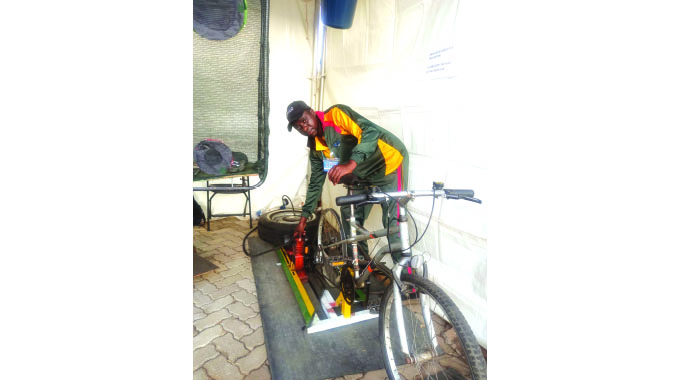
Sifelani Tsiko
Innovations Editor
For years, Washington Mutara, a primary school teacher and a University of Zimbabwe sporting science student, was always concerned about the history of exclusion of the fitness industry.
The fact that the fitness industry catered for the needs of middle and upper-class people with better disposable income worried him a lot.
Just as the rich get richer, the fit tend to get fitter and too often, the poor in most rural areas and high density locations without access to sporting equipment and facilities get sicker.
All this was particularly upsetting for Mutara, who teaches at Tafara 5 Primary School in Harare and has observed first-hand how lack of cheap and affordable gym equipment reduces access to exercise for the majority of the poor.
“Lack of access to cheaper and affordable exercise equipment has exacerbated health problems for the poor particularly now when there is a rise in non-communicable diseases,” Mutara told The Herald at the UZ Research Innovation and Industrialisation Week event.
“I have a school coaching background. I teach at a council school in Tafara and really didn’t know anything about manufacturing. Motivated by the desire to ensure the poor have access to basic training and exercising equipment, I developed a pressure – based cycling system made from old materials,” he said.
“Modern gym equipment is very expensive and inaccessible to the majority of the poor. It does a great disservice to the health needs of the poor. However, through my own homemade exercise gadget, this should not paralyse people in realising the benefits of exercise for their own health in their own homes.”
Mutara made a gadget called a “Pressure – based Ergometer” – made cheaply from welded iron frame, with an old tyre, old grinding mill belts, an old bicycle, a pressure gauge worth US$2 and a compressor that only cost about US$75.
“Its basically a cycling gadget made from old items. As you cycle you pump air through a pipe connected to the old tyre. So one will be cycling and pumping pressure into the tyre. Cycling is lighter when it’s not connected to the tyre and it becomes heavier when it is connected to the tyre,” he said.
“It increases resistance and this is good for muscle strength and endurance. For less than US$100, you can make equipment yourself or have it cheaply made by a welder. Brand new and imported cycling gym equipment can cost more than US$2 000 depending on the quality and brand.
“Most schools and people in poor urban and rural areas cannot afford such equipment and yet they too deserve better access to fitness equipment.”
Mutara started developing the cost – effective piece of home gym equipment in 2021 when he enrolled at the UZ for his Msc in Sporting Science degree.
“The purpose of this device is to ensure fitness targeting muscle strength and endurance to help fight non-communicable diseases. I developed this device which is cheaper and affordable for the poor to exercise,” he said.
The message of health, wellness, and disease prevention through physical activity has become more widespread in Zimbabwe and most African countries in recent years.
Along with much of the population, the poor are also looking toward health clubs, gyms and fitness centres as a means to be more active and achieve a healthy lifestyle.
In a fitness facility, exercise equipment, programs and policies themselves contribute to an environment that promotes equal access and use by all members.
“Home – made gym equipment which is cheaper and affordable can make exercise and training more appealing and accessible to more people, particularly in poor urban and rural set ups,”Mutara said.
“We have to remove barriers through supporting initiatives to make home – made gym equipment using recycled materials which is cheaper and more readily available.
“Jogging or cycling along roads has become risky. People can be mugged or run over by cars and having such a cheap gadget installed at home, in schools, community halls, clinics and other leisure facilities can enhance access to training facilities and reduce the medical bill to the nation.”
Basic fitness equipment has the potential to enhance the health for many underserved populations in the country.
Mutara’s creative, simple and accessible solution can help maintain good fitness and health for the majority of the poor.
Access to cheaper and affordable fitness equipment can help more people to participate in any form of exercise plan.
Lack of access to cheaper equipment and sedentary lifestyle often lead to poor fitness, obesity and health complications like hypertension and diabetes.
“The cost of making this device is minimal and if I get more funding, I can make plenty of them at a lower cost. Through a massive roll out of cheaper and affordable equipment we can help fight drug abuse among the youths in our ghettos and rural areas,” Mutara said.
“All people have the same right to exercise and be fit and healthy. With this device we can make exercise more accessible and inclusive of all people.”
Non-communicable diseases such as cancer, cardiovascular diseases and diabetes are rising in Zimbabwe and most other African countries.
The World Health Organisation says the rising burden of non-communicable diseases will exert pressure on treatment and care services on the continent.
In Africa, the number of people living with diabetes, for example, is expected to reach 47 million by 2045 up from 19 million in 2019.
